|
|
|
|
|
|
|
|
|
In 1928, the Southern Railway began installing subsidiary semaphore arms coloured white with a red horizontal stripe along the middle. Initially, calling-on signals with this style of arm carried no distinguishing letter [3.49 & 3.50], whereas shunt-ahead and warning signals had a red distinguishing letter "S" or "W" attached to the front of the arm [3.51 - 3.54].
 |
 |
|
[3.49] Subsidiary Signal ('on').
Area: Southern Railway Usage: Low Status: Historical |
[3.50] Calling-on Signal ('off').
Area: Southern Railway Usage: Low Status: Historical |
|---|---|
 |
 |
|
[3.51] Shunt-ahead Signal ('on').
Area: Southern Railway Usage: Medium Status: Historical |
[3.52] Shunt-ahead Signal ('off').
Area: Southern Railway Usage: Medium Status: Historical |
 |
 |
|
[3.53] Warning Signal ('on').
Area: Southern Railway Usage: Low Status: Historical |
[3.54] Warning Signal ('off').
Area: Southern Railway Usage: Low Status: Historical |
In some cases, a single subsidiary arm could function as either a shunt-ahead signal or a warning signal depending on the circumstances that required it to be cleared. An arm that performed two functions had no letter fitted (see [3.49]), but when it moved to the 'off' position, a letter "S" or "W" was displayed alongside in a separate indicator [3.55 & 3.56].
 |
 |
|
[3.55] Shunt-ahead Signal ('off').
Area: Southern Railway Usage: Low Status: Historical |
[3.56] Warning Signal ('off').
Area: Southern Railway Usage: Low Status: Historical |
|---|
Later in 1928, the Southern Railway was installing calling-on signals with a red letter "C" fitted to the arm [3.57 & 3.58], and the same letter was retrospectively fitted to each of the white calling-on arms not originally provided with one (see [3.49 & 3.50]).
 |
 |
|
[3.57] Calling-on Signal ('on').
Area: Southern Railway Usage: Medium Status: Historical |
[3.58] Calling-on Signal ('off').
Area: Southern Railway Usage: Medium Status: Historical |
|---|
In some early colour light signalling schemes (e.g. the Great Western Railway's Engine and Carriage lines between London Paddington and Old Oak Common, in December 1928), calling-on signals comprised a small green light mounted below the main signal head. The light was normally extinguished, it being lit only when required to authorise a movement past the main signal [3.59]. The resignalling of the Manchester Victoria - Manchester Exchange area on the LMS in March 1929 included miniature colour light type calling-on signals that displayed a similar small green light when 'off'; however, these signals followed semaphore practice by displaying a small white light for location purposes when 'on' [3.60].
 |
 |
|
[3.59] Calling-on Signal ('off').
Area: Various Usage: Medium Status: Historical |
[3.60] Calling-on Signal ('on').
Area: Manchester Victoria - Manchester Exchange, LMS Usage: Medium Status: Historical |
|---|
During discussions on the standardisation of signalling equipment, joint sub-committees of the Railway Clearing House recommended in December 1928 that the standard form of subsidiary arm should be coloured white with red horizontal stripes at top and bottom (see [3.45 & 3.46]); this recommendation was approved by the Superintendent's (Operating) Committee on 23 January 1929. From early 1929, the Southern Railway was installing subsidiary signals coloured accordingly but retaining a red distinguishing letter on the arm [3.61 - 3.66].
 |
 |
 |
|
[3.61] Calling-on Signal ('on').
Area: Southern Railway Usage: Medium Status: Historical |
[3.62] Lower Quadrant Calling-on Signal ('off').
Area: Southern Railway Usage: Medium Status: Historical |
[3.63] Upper Quadrant Calling-on Signal ('off').
Area: Southern Railway Usage: Medium Status: Historical |
|---|---|---|
 |
 |
 |
|
[3.64] Shunt-ahead Signal ('on').
Area: Southern Railway Usage: Medium Status: Historical |
[3.65] Lower Quadrant Shunt-ahead Signal ('off').
Area: Southern Railway Usage: Medium Status: Historical |
[3.66] Upper Quadrant Shunt-ahead Signal ('off').
Area: Southern Railway Usage: Medium Status: Historical |
|
|
|